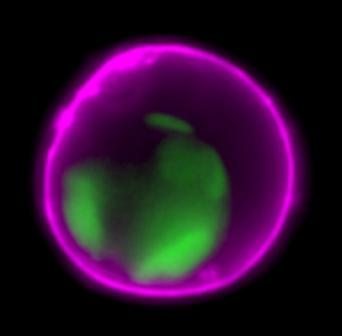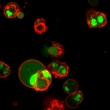Dual Apoptosis Assay with NucView® 488 Caspase-3 Substrate & Annexin V
These kits provides two apoptosis markers, our novel NucView® 488 Caspase-3 Substrate and Annexin V conjugate for detecting caspase-3 activation and phosphatidylserine (PS) translocation.
Please fill in the inquiry form and we will contact you shortly.
Wishlist updated! View wishlist
Product Description
These kits provides two apoptosis markers, our novel NucView® 488 Caspase-3 Substrate and fluorescent CF® dye Annexin V for detecting two important apoptosis events, caspase-3 activation and phosphatidylserine (PS) translocation.
Features
- Detect caspase activity & phosphatidylserine exposure
- Rapid, 15-30 minute staining
- For flow cytometry or fluorescence microscopy
- Formaldehyde fixable
- Choice of red or far-red fluorescent Annexin V
- Featuring bright & photostable CF® dyes
Kit Components
- NucView® 488 Caspase-3 Substrate, 0.2 mM in DMSO
- Choice of Annexin V Conjugate (human, recombinant, produced in E. coli)
- 5X Annexin Binding Buffer
- Ac-DEVD-CHO Caspase-3 Inhibitor, 2 mM in DMSO
Spectral Properties
- NucView® 488: Ex/Em 500/530 nm (after cleavage, with DNA)
- Texas Red® Annexin V: Ex/Em 594/615 nm
- CF®594 Annexin V: Ex/Em 593/614 nm
- CF®640R Annexin V: Ex/Em 642/662 nm
The rate of apoptosis varies from cell to cell even within the same population. As a result, various apoptotic events or markers accompanying the apoptotic process also occur differently among cells. Thus, it is important to be able to detect these apoptotic events on an individual cell basis. Traditionally, caspase activity has been detected either using a membrane-impermeable fluorogenic enzyme substrate such as DEVD-R110, or a fluorescently-labeled inhibitor such as a FLICA reagent. In the former case, cell lysis is required, thus precluding the detection of caspase activity in live cells. In addition, such caspase assays measure only the average caspase activity of a highly heterogeneous cell population at a given time. In the latter case, although a FLICA reagent can enter live cells to detect caspase activity, only the initial fluorescent signal following the application of the reagent can truly reflect the enzyme activity or the state of the apoptotic cells because any detected signal after the initial “snapshot” will need to consider the potential interference of the inhibitor to the enzyme and the apoptotic cell itself.
Unlike conventional caspase assays, NucView® 488 Caspase-3 substrate detects caspase-3 activity within individual whole cells in a non-interfering manner. The substrate consists of a fluorogenic DNA dye and a DEVD substrate moiety specific for caspase-3. The substrate, which is both non-fluorescent and nonfunctional as a DNA dye, rapidly crosses cell membranes to enter the cytoplasm, where it is cleaved by caspase-3 to form a high-affinity DNA dye that stains the nucleus bright green. Thus, the NucView® 488 caspase-3 substrate is bi-functional, allowing detection of caspase-3 activity and visualization of apoptotic nuclear morphology.
The kit contains reagents sufficient for 50 flow cytometry assays (200 uL assay volume). The number of fluorescence microscopy assays that can be performed with the kit may vary based on the size of culture vessel and staining volume used.
To learn about the advantages of monitoring apoptosis using NucView® caspase-3 substrates, visit the NucView® Technology Page.
References
1. Reproductive BioMedicine Online (2008) 16(5), 657-663. www.rbmonline.com/Article/3185
2. Curr Trends Biotech Pharm (2009) 3(3), 278-286. ISSN 0973-8916
3. Malaysian Journal of Chemistry (2009) Vol 11(1), 136-142.
4. Malaysian Journal of Chemistry (2009) 11(1), 143 – 148.
5. Pharmacognosy Res (2010) 2(2), 113-119. doi: 10.4103/0974-8490.62949
6. Mol Cancer Res (2013) 11(4), 405–17. DOI: 10.1158/1541-7786.MCR-12-0551
7. Stem Cells (2013) 31, 1121–1135. doi: 10.1002/stem.1368
8. Stem Cells (2013) 31, 2374–2387. https://doi.org/10.1002/stem.1509
9. Journal of Cell Science (2014) 127, 1738-1750. doi: 10.1242/jcs.138214
10. PLoS Genet (2014) 10(10), e1004594. doi:10.1371/journal.pgen.1004594
11. Cancer Gene Therapy (2016) Cancer Gene Ther 23(6), 178-87. doi:10.1038/cgt.2016.18
12. Current Cancer Drug Targets (2018) 18, 1-9. DOI:10.2174/1568009617666171114144236
13. Sci Rep (2018) 8, 13192. DOI:10.1038/s41598-018-31575-3
Find a list of NucView® references and a list of validated cell lines under Supporting Documents.




